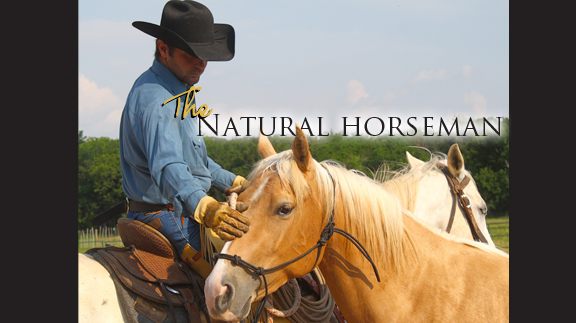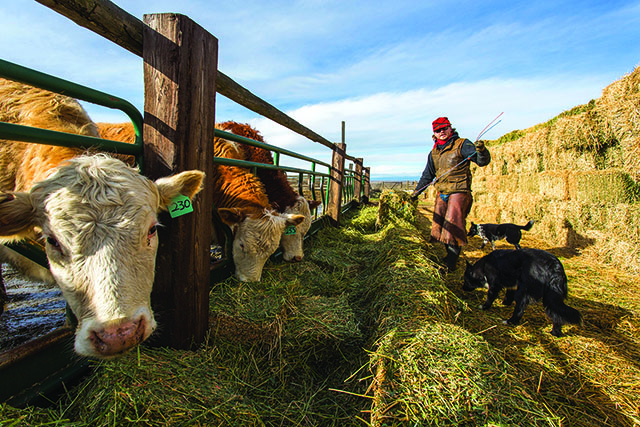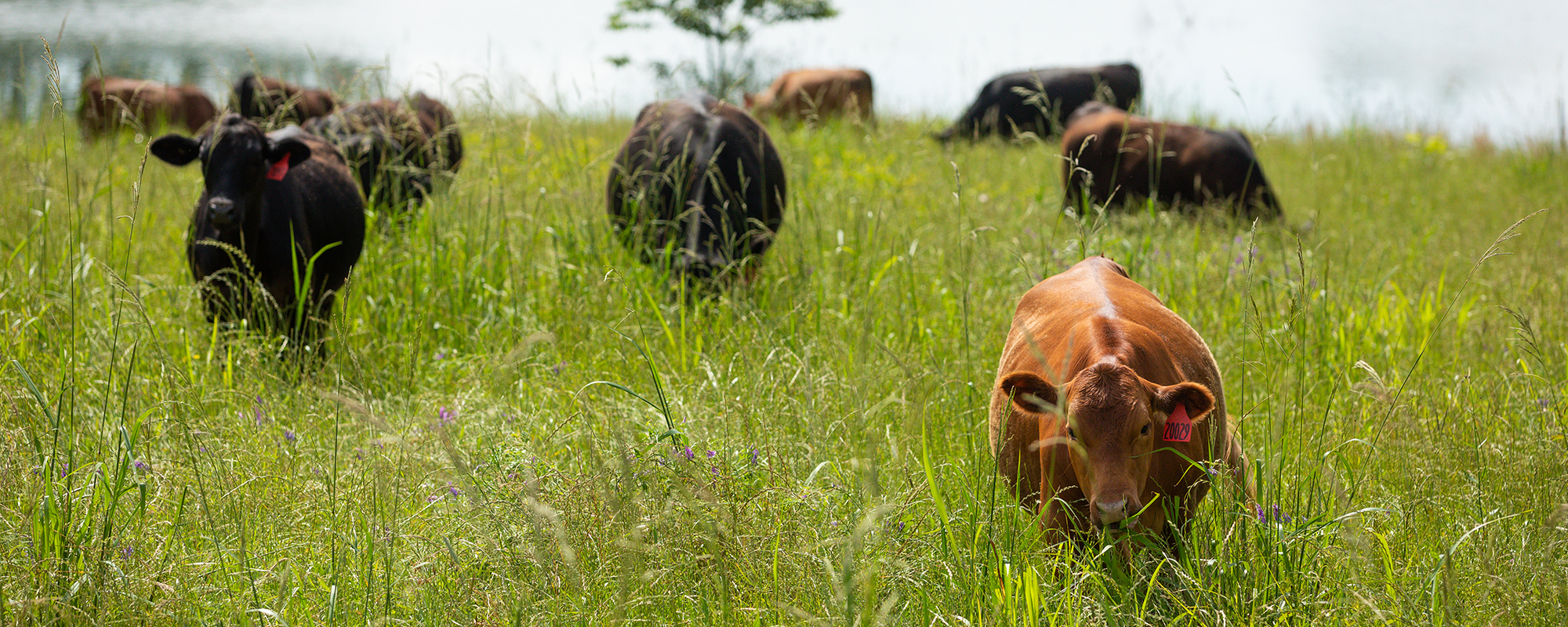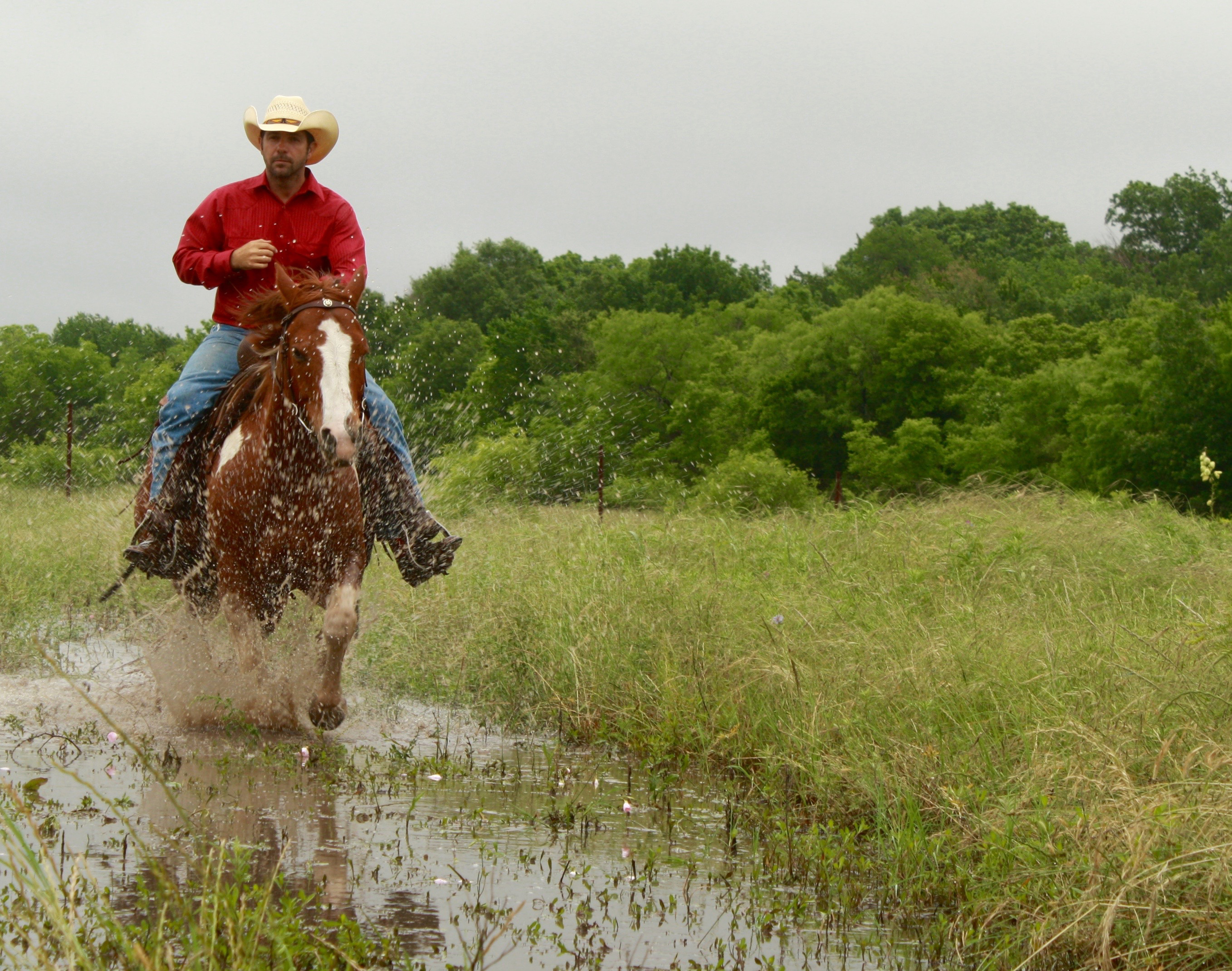HOME
The Natural Horseman – Riding Through the Mud

By Steve Stevens
The Texas Ranger has a handlebar mustache and lines running across his face showing every haunting experience in his life. Every outlaw chased shows through each nook and cranny of his tanned leather skin. His steel eyes gleam through the caked dust blown up from a line of storms starting in the Hill Country working their way east. Although the storms are bringing torrential rain, he never wavers in his quest to hunt down the Comanches who just raided a small town. As the rain thickens and the lightning crashes, he finds himself and his stout bay gelding at a full out run through the black clay landscape. His faithful mount hammers on through the pounding gust of sleet waiting for his next command. The Ranger rides light in his saddle to stay loose on his back in case of a trip or fall. The many miles have taught him how to be aware of his horse’s footfall in the most difficult of situations and how to help his gelding prevail through every slick unbalanced stride that he takes in the Texas mud.
I know it seems far-fetched, but I think often of our Western heritage and what it might have been like back then and what man and his partner the horse endured, especially this time of year when we seem to be back in a rain pattern that could potentially drop rain weekly through the rest of fall and winter.
We don’t have the benefit of an indoor arena, so finding safe, proactive ways to work horses in training when the ground is wet can take some getting used to. This is especially true when riding colts and problem horses that aren’t sure footed yet. Long term, it is a great opportunity to build a horse’s confidence in sticky situations, excuse the pun. But you really have to use your awareness. A lot of the property here is a clay mixture and it can be like walking on ice, so it is a great time to really focus on footfall. Not being paranoid, but staying in the moment—feeling each step fall deep and sturdy in the ground. If you are not connected to your horse and balanced on this kind of ground, you can impede his ability to stay on his feet very easily.
Lots of times we don’t have control of our environment: weather on the trail, a freak storm that comes up, entered at the rodeo that is never canceled due to rain, or just needing to get some colts trained in the mud. It is not necessarily something I enjoy doing, but riding in the mud is a reality. It is good to get horses used to all environments, within reason.
If you haven’t ridden in the mud before, the important thing is to be aware of the footing or should I say the ground. If there is good footing under the mud there will still be solid ground underneath your horse, and as long as you are aware and pay attention to things, it will be fine. If you have to ride through slicker stuff, you really need to take your time by focusing on each step and staying balanced and light in the saddle.
So next time you are stuck riding in the mud, think about those before us who discovered our beautiful country horseback and all the millions of miles they rode through the mud!
HOME
Farm and Ranch Injuries

By Barry Whitworth, DVM
In January, I attended the Oklahoma Veterinary Conference. While waiting for one of the sessions to start, a classmate of mine commented how many of the attendees walk with a limp, used a cane, and/or have damaged hands. We all agreed that working with animals is hard on the body. In general, anything associated with farming and ranching is dangerous.
Most farmers and ranchers know that agriculture is a dangerous occupation. According to United States Bureau of Statistics, workers involved in agriculture, forestry, and fishing had the highest occupational fatality rate in 2022. The fatality rate of 23.5 per 100,000 full-time equivalent (FTE) workers for this group is much higher when compared to the overall occupation fatality rate of 3.7 per 100,000 FTE. Most of the agriculture-related fatalities are associated with transportation, such as tractor overturns, and vehicle crashes, but a fair number involve livestock.
To read more, pick up a copy of the March issue of NTFR magazine. To subscribe by mail, call 940-872-5922.
HOME
Jesses Jewelz

By Jesse Kader
Comfy and keep it western. That’s the name of the game this month. It’s hot and who wants clingy clothing? This jumpsuit is perfectly comfortable and relaxed without forfeiting the fashion. Dress it up or keep it casual. See this and more at www.jessesjewelz.com.
HOME
Noble Research Institute Expands New Program Offering Farmers and Ranchers the Essentials of Regenerative Ranch Management

The educational program has been expanded to three new locations, empowering ranchers and farmers to monitor and improve the health of their land, livestock and livelihood through regenerative principles.
ARDMORE, OK–September 12, 2023 – Noble Research Institute announced the expansion of Essentials of Regenerative Ranching, a new educational program designed to help ranchers enhance and restore the land, making it more resilient and reaching livestock grazing goals through regenerative management. Essentials of Regenerative Ranching provides producers with practical tools, hands-on experience and guidance to make data-driven decisions to decrease costs and improve profit.
The Essentials of Regenerative Ranching course has been expanded to three new locations in Texas and Oklahoma. Registration is open now at www.noble.org/essentials. Seating is limited, so early registration is recommended.
Texas A&M
College Station, Texas
October 17 – 18
O.D. Butler, Jr. Animal Science Complex
Noble Research Institute
Ardmore, Oklahoma
October 31 – November 1
Pavilion Center
Texas A&M
Kingsville, Texas
November 7-8
Caesar Kleberg Wildlife Center
“Program participants gain working knowledge and experience of monitoring and improving the health of their soil, grazing livestock more strategically and making informed financial decisions,” said Hugh Aljoe, Noble Research Institute’s director of ranches, outreach and partnerships. “We use a mix of classroom and field work to send producers home with the tools they need to begin making changes on their ranch.”
Farmers and ranchers navigate uncertainty from weather, fluctuating market prices and escalating costs of inputs. Many producers are seeking new tools that offer greater control and reduce their operational uncertainty. Through this course, ranchers and farmers will calculate their financial situations, determine initial stocking rates, carrying capacity and grazing goals.
“The course is well-suited for ranchers of all experience levels and all types and sizes of operations,” Aljoe added. “No matter your situation, this program will transform the way you think about your ranch.”
The Essentials of Regenerative Ranching program allows producers to overcome obstacles, become more informed problem-solvers and increase the productivity of their grazing lands. By participating in this program, ranchers join a community of like-minded producers who are shaping the future of ranching and leaving a lasting impact on their land and families. “If I had known what I learned in this course when I started my regenerative journey, I could have avoided some key mistakes,” said Tana McCarter, a rancher, and Essentials attendee. “I left with the tools I needed to monitor my soil health and financial progress. I’ll now have the right data to make informed decisions on how to meet my regenerative goals.”
Noble Research Institute is an independent nonprofit agricultural research organization dedicated to guiding farmers and ranchers in applying regenerative principles that yield healthier soil, more productive grazing land, and business success.
At Noble, researchers, facilitators and ranch staff work together to share with farmers and ranchers the skills and tools to regenerate the land in a profitable manner. Noble is focused on the regenerative management of the nation’s grazing acres, which directly impacts pasture and range environments, wildlife, pecan production, and livestock production. Regenerative management recognizes that each decision made on the ranch impacts the interactions of the soil, plants, water, animals, economics and people. Noble’s 14,000 acres of working ranch lands provide a living laboratory on which to demonstrate and practice regenerative principles and ideas to deliver value to farmers and ranchers across the U.S.
-

 Country Lifestyles1 year ago
Country Lifestyles1 year agoScott & Stacey Schumacher: A Growth Mindset
-

 Equine7 months ago
Equine7 months agoThe Will to Win
-

 Country Lifestyles7 years ago
Country Lifestyles7 years agoStyle Your Profile – What your style cowboy hat says about you and new trends in 2017
-

 Country Lifestyles4 years ago
Country Lifestyles4 years agoAmber Crawford, Breakaway Roper
-

 HOME7 years ago
HOME7 years agoGrazing North Texas – Wilman Lovegrass
-

 Country Lifestyles7 years ago
Country Lifestyles7 years agoDecember 2016 Profile, Rusty Riddle – The Riddle Way
-

 Country Lifestyles8 years ago
Country Lifestyles8 years agoJune 2016 Profile – The man behind the mic: Bob Tallman
-

 Outdoor9 years ago
Outdoor9 years agoButtercup or Primrose?







